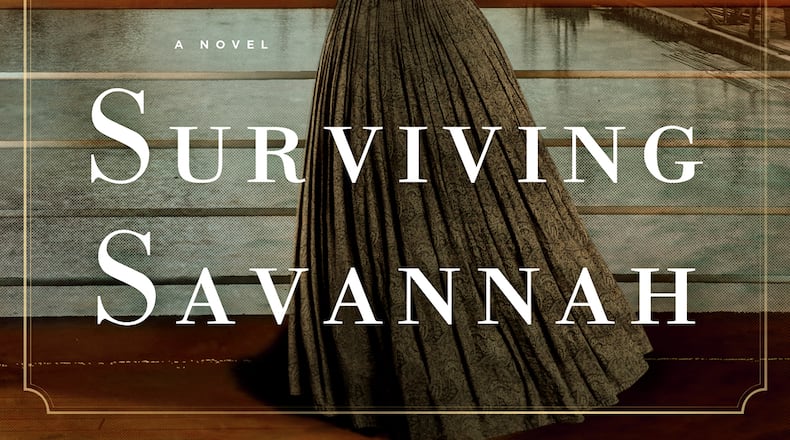Society places an expectation on people who narrowly escape death, presuming the spared will be so grateful for their extra time on Earth they will live with renewed vigor and altruistic purpose. But that doesn’t take into account survivors who experience yet another struggle on the other side of an intensely traumatic experience, one that requires them to “survive the surviving.”
Patti Callahan explores that concept in “Surviving Savannah,” her new historical novel based on the true story of a steamship that sank while carrying many of Savannah’s privileged class in June 1838. When the steamship Pulaski’s starboard boiler exploded 183 years ago, what was “meant to be a one-night-at-sea celebration of summer’s arrival” turned into a terrifying “test of fate, luck, fortitude and God’s providence.” Of the nearly 200 crew and passengers aboard the ship, history records 59 survivors.
Following Callahan’s 2018 historical fiction “Becoming Mrs. Lewis,” “Surviving Savannah” continues the author’s departure from a long list of Southern contemporary novels. The timing of her story, which features a braided narrative and spans centuries, proved serendipitous. She was a few weeks into her research when explorers found the wreck’s remnants 30 miles off the coast of North Carolina. That development shows up in the novel’s modern-day timeline when Everly Winthrop, a Savannah College of Art and Design history professor, is asked to guest-curate an exhibit of the recovered artifacts: coins, candlesticks, a gold pocket watch with the hands frozen at the time of the explosion.
Credit: Handout
Credit: Handout
The 19th century timeline unfolds from the perspectives of two women: Lilly Forsyth, who is traveling with her infant daughter and enslaved nursemaid Priscilla, and Lilly’s 22-year-old aunt Augusta Longstreet, whose brother — a plantation owner and financier instrumental in the ship’s construction — is also on board with his wife and six children.
The Pulaski has been referred to as the Titanic of the South, and though the disasters are distinct in history, those familiar with the blockbuster film may recognize parallels between the oppression of Lilly by her greedy, abusive husband and James Cameron’s characters, Rose and Cal.
Meanwhile, Augusta is “as well read and educated as (her brother) was, but her status as a woman set them worlds apart.” Callahan explores the ramifications of that disparity in both the past and the present. While conducting research for the exhibit, Everly discovers that the ship manifest doesn’t list first names for women or any names for enslaved people. During the Pulaski disaster, the too-tight corset on a woman struggling to survive at sea contributes to her death.
Augusta and Lilly both survive the ship’s brutal destruction, and in the process their eyes are opened to the humanity of the enslaved people with whom they are stranded with at sea. White guilt sets in as Augusta realizes how easy it had been for her to proclaim slavery an abominable institution “when she’d had no power to change the institution.” While drifting on a large piece of decking from the ship, she starts to see “her life through a lens that had been clouded with creature comforts and willful blindness.”
Floating to shore in a lifeboat with her infant daughter and Priscilla, Lilly recognizes that they are no longer “mistress and slave but two women intent on survival.” For the first time, Lilly engages Priscilla as an equal and asks questions about her life.
Credit: Bud Johnson Photography
Credit: Bud Johnson Photography
In large part, the story’s emotional core hinges on Lilly and her redemption, but her character could use more fleshing out to successfully pull it off. It’s hard to muster sympathy for an aristocrat with a hand in slavery, even one who’s abused by her husband and thrown into a horrifying, life-and-death situation. Because too much of Priscilla’s story is glossed over, Lilly’s reckoning doesn’t fully resonate.
The success of “Surviving Savannah” can be found in Callahan’s ability to vividly bring to life a fascinating, harrowing slice of history that should be as well-known as the Titanic, especially for Southerners.
“The idea that surviving brings everyone to a new and better place is a lie told by people who need the world to make sense,” observes a character in “Surviving Savannah.” The proof is in the 14-year-old survivor who goes on to become an illegal slave trader and, incidentally, the last man to die in the Civil War.
The lives of the passengers on the Pulaski are contextualized by Everly, whose research for the exhibit renders her “a ghost running between centuries, both connected to the survivors and untethered from the present.”
Still grief-stricken from having witnessed a drunk driver kill her best friend, Everly ponders the role fate plays in life and death while hunting for information on the Longstreet family. Poetically, it’s the bottom of the ocean where she finds some clarity and a will to go on living. As Everly gets closer to the truth of what happened to Lilly, closure for her own trauma becomes more attainable.
FICTION
‘Surviving Savannah’
By Patti Callahan
Berkley Publishing Group
432 pages, $26
About the Author
The Latest
Featured



